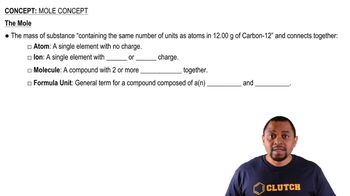The following diagram represents the collection of elements formed by a decomposition reaction. (a) If the blue spheres represent N atoms and the red ones represent O atoms, what was the empirical formula of the original compound?
Glycine, an amino acid used by organisms to make proteins, is represented by the following molecular model. (c) Calculate how many moles of glycine are in a 100.0-g sample of glycine.
 Verified step by step guidance
Verified step by step guidance
Verified video answer for a similar problem:
Key Concepts
Molar Mass

Mole Concept

Stoichiometry

The following diagram represents the collection of CO2 and H2O molecules formed by complete combustion of a hydrocarbon. What is the empirical formula of the hydrocarbon?
Glycine, an amino acid used by organisms to make proteins, is represented by the following molecular model. (a) Write its molecular formula.
Glycine, an amino acid used by organisms to make proteins, is represented by the following molecular model. (d) Calculate the percent nitrogen by mass in glycine.
The following diagram represents a high-temperature reaction between CH4 and H2O. Based on this reaction, find how many moles of each product can be obtained starting with 4.0 mol CH4.
Based on this reaction, find how many moles of CO can be obtained starting with 4.0 mol CH4?
The following diagram represents a high-temperature reaction between CH4 and H2O. Based on this reaction, find how many moles of each product can be obtained starting with 4.0 mol CH4. Based on this reaction, how many moles of H2 can be obtained starting with 4.0 mol CH4?
